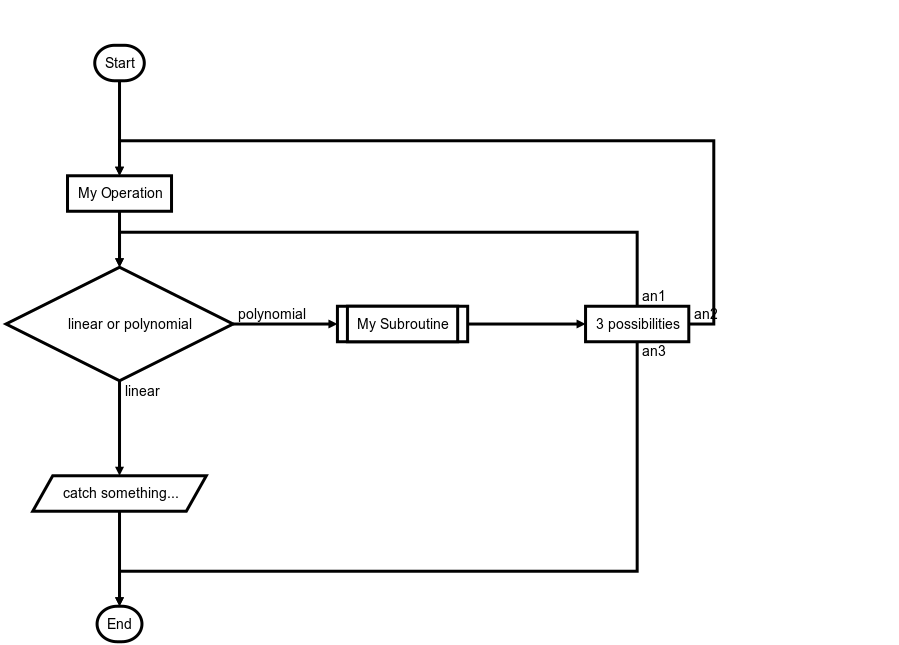flowchart.js
flowchart.js is a flowchart DSL and SVG render that runs in the browser and terminal.
Nodes and connections are defined separately so that nodes can be reused and connections can be quickly changed. Fine grain changes to node and connection style can also be made right in the DSL.
Example
st=>start: Start:>http://www.google.com[blank] e=>end:>http://www.google.com getInfo=>input: Input Info op1=>operation: My Operation sub1=>subroutine: My Subroutine cond=>condition: Yes or No?:>http://www.google.com io=>inputoutput: catch something... printInfo=>output: Print info para=>parallel: parallel tasks st->getInfo->op1->cond cond(yes)->io->printInfo->e cond(no)->para para(path1, bottom)->sub1(right)->op1 para(path2, top)->op1
CLI
See francoislaberge/diagrams on how to flowchart.js in the terminal.
Browser Usage
flowchart.js is on CDNJS, feel free to use it.
You will also need Raphaël, which is also on CDNJS.
The demo html page is at example/index.html.
Node Syntax
nodeName=>nodeType: nodeText[|flowstate][:>urlLink]
Items in [] are optional.
nodeName defines the nodes variable name within the flowchart document.
nodeType defines what type the node is. See Node Types for more information.
nodeText is the text that will be inserted into the node. Newlines are allowed and will be reflected in the rendered node text.
flowstate is optional and uses the | operator that specifies extra styling for the node.
urlLink is optional and uses the :> operator to specify the url to link to.
Node Types
Defines the shape that the node will take.
start
Used as the first node where flows start from.
Default text is Start.

st=>start: start
end
Used as the last node where a flow ends.
Default text is End.

e=>end: end
operation
Indicates that an operation needs to happen in the flow.

op1=>operation: operation
inputoutput
Indicates that IO happens in a flow.

io=>inputoutput: inputoutput
input
Indicates that Input happens in a flow.

getInfo=>input: Input info
output
Indicates that Output happens in a flow.

printInfo=>output: Print info
subroutine
Indicates that a subroutine happens in the flow and that there should be another flowchart that documents this subroutine.

sub1=>subroutine: subroutine
condition
Allows for a conditional or logical statement to direct the flow into one of two paths.

cond=>condition: condition Yes or No?
parallel
Allows for multiple flows to happen simultaneously.

para=>parallel: parallel
Connections
Connections are defined in their own section below the node definitions.
The -> operator specifies a connection from one node to another like nodeVar1->nodeVar2->nodeVar3.
Not all nodes need to be specified in one string and can be separaged like so
nodeVar1->nodeVar2 nodeVar2->nodeVar3
Connection syntax is as follows:
<node variable name>[(<specification1>[, <specification2])]-><node variable name>[[(<specification1>[, <specification2])]-><node variable name>]
Items in [] are optional.
Directions
The following directions are available and define the direction the connection will leave the node from. If there are more than one specifiers, it is always the last. All nodes have a default direction making this an optional specification. <direction> will be used to indicate that one of the following should be used in its place.
- left
- right
- top
- bottom
Node Specific Specifiers by Type
Each node variables has optional specifiers, like direction, and some have special specifiers depending on the node type that are defined below. Specifiers are added after the variable name in () and separated with , like nodeVar(spec1, spec2).
start
Optional direction
startVar(<direction>)->nextNode
end
No specifications because connections only go to the end node and do not leave from it.
previousNode->endVar
operation
Optional direction
operationVar(<direction>)->nextNode
inputoutput
Optional direction
inputoutputVar(<direction>)->nextNode
subroutine
Optional direction
subroutineVar(<direction>)->nextNode
condition
Required logical specification of yes or no
Optional direction
conditionalVar(yes, <direction>)->nextNode1 conditionalVar(no, <direction>)->nextNode2
parallel
Required path specification of path1, path2, or path3
Optional direction
parallelVar(path1, <direction>)->nextNode1 parallelVar(path2, <direction>)->nextNode2 parallelVar(path3, <direction>)->nextNode3
Links
A external link can be added to a node with the :> operator.
The st node is linked to http://www.google.com and will open a new tab because [blank] is at the end of the URL.
The e node is linked to http://www.yahoo.com and will cause the page to navigate to that page instead of opening a new tab.
st=>start: Start:>http://www.google.com[blank] e=>end: End:>http://www.yahoo.com
Advice
Symbols that should possibly not be used in the text: => and -> and :> and | and @> and :$
If you want to emphasize a specific path in your flowchart, you can additionally define it like this:
st@>op1({"stroke":"Red"})@>cond({"stroke":"Red","stroke-width":6,"arrow-end":"classic-wide-long"})@>c2({"stroke":"Red"})@>op2({"stroke":"Red"})@>e({"stroke":"Red"})
Custom names for branches
st=>start: Start:>http://www.google.com[blank]
e=>end:>http://www.google.com
op1=>operation: My Operation
sub1=>subroutine: My Subroutine
cond=>condition: linear or polynomial :>http://www.google.com
io=>inputoutput: catch something...
para=>parallel: 3 possibilities
st->op1->cond
cond(true@linear)->io->e
cond(false@polynomial)->sub1(right)
sub1(right)->para
para(path1@an1, top)->cond
para(path2@an2, right)->op1
para(path3@an3, bottom)->e

Contributors
via GitHub
Thanks
Many thanks to js-sequence-diagrams which greatly inspired this project, and forms the basis for the syntax.
编辑推荐精选


Vora
免费创建高清无水印Sora视频
Vora是一个免费创建高清�无水印Sora视频的AI工具


Refly.AI
最适合小白的AI自动化工作流平台
无需编码,轻松生成可复用、可变现的AI自动化工作流


酷表ChatExcel
大模型驱动的Excel数据处理工具
基于大模型交互的表格处理系统,允许用户通过对话方式完成数据整理和可视化分析。系统采用机器学习算法解析用户指令,自动执行排序、公式计算和数据透视等操作,支持多种文件格式导入导出。数据处理响应速度保持在0.8秒以内,支持超过100万行数据的即时分析。


TRAE编程
AI辅助编程,代码自动修复
Trae是一种自适应的集成开发环境(IDE),通过自动化和多元协作改变开发流程。利用Trae,团队能够更快速、精确地编写和部署代码,从而提高编程效率和项目交付速度。Trae具备上下文感知和代码自动完成功能,是提升开发效率的理想工具。


AIWritePaper论文写作
AI论文写作指导平台
AIWritePaper论文写作是一站式AI论文写作辅助工具,简化了选题、文献检索至论文撰写的整个过程。通过简单设定,平台可快速生成高质量论文大纲和全文,配合图表、参考文献等一应俱全,同时提供开题报告和答辩PPT等增值服务,保障数据安全,有效提升写作效率和论文质量。


博思AIPPT
AI一键生成PPT,就用博思AIPPT!
博思AIPPT,新一代的AI生成PPT平台,支持智能生成PPT、AI美化PPT、文本&链接生成PPT、导入Word/PDF/Markdown文档生成PPT等,内置海量精美PPT模板,涵盖商务、教育、科技等不同风格,同时针对每个页面提供多种版式,一键自适应切换,完美适配各种办公场景。


潮际好麦
AI赋能电商视觉革命,一站式智能商拍平台
潮际好麦深耕服装行业,是国内AI试衣效果最好的软件。使用先进AIGC能力为电商卖家批量提供优质的、低成本的商拍图。合作品牌有Shein、Lazada、安踏、百丽等65个国内外头部品牌,以及国内10万+淘宝、天猫、京东等主流平台的品牌商家,为卖家节省将近85%的出图成本,提升约3倍出图效率,让品牌能够快速上架。


iTerms
企业专属的AI法律顾问
iTerms是法大大集团旗下法律子品牌,基于最先进的大语言模型(LLM)、专业的法律知识库和强大的智能体架构,帮助企业扫清合规障碍,筑牢风控防线,成为您企业专属的AI法律顾问。


SimilarWeb流量提升
稳定高效的流量提升解决方案,助力品牌曝光
稳定高效的流量提升解决方案,助力品牌曝光


Sora2视频免费生成
最新版Sora2模型免费使用,一键生成无水印视频
最新版Sora2模型免费使用,一键生成无水印视频
推荐工具精选
AI云服务特惠
懂AI专属折扣关注微信公众号
最新AI工具、AI资讯
独家AI资源、AI项目落地

微信扫一扫关注公众号







